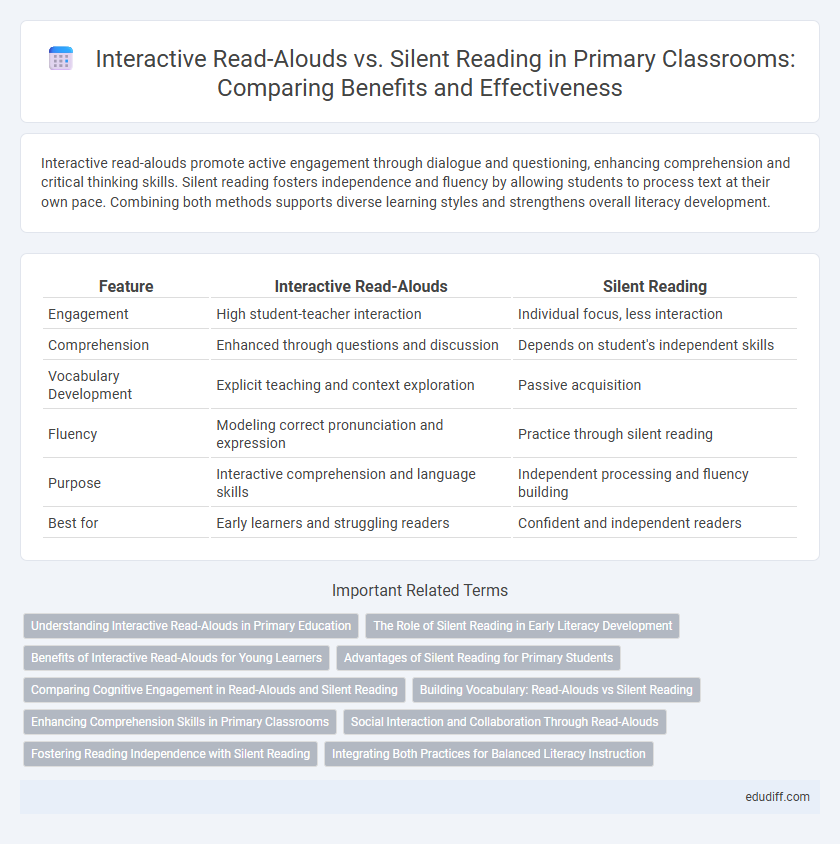Interactive read-alouds promote active engagement through dialogue and questioning, enhancing comprehension and critical thinking skills. Silent reading fosters independence and fluency by allowing students to process text at their own pace. Combining both methods supports diverse learning styles and strengthens overall literacy development.
Table of Comparison
| Feature | Interactive Read-Alouds | Silent Reading |
|---|---|---|
| Engagement | High student-teacher interaction | Individual focus, less interaction |
| Comprehension | Enhanced through questions and discussion | Depends on student's independent skills |
| Vocabulary Development | Explicit teaching and context exploration | Passive acquisition |
| Fluency | Modeling correct pronunciation and expression | Practice through silent reading |
| Purpose | Interactive comprehension and language skills | Independent processing and fluency building |
| Best for | Early learners and struggling readers | Confident and independent readers |
Understanding Interactive Read-Alouds in Primary Education
Interactive read-alouds in primary education significantly enhance comprehension by actively engaging students with questions, predictions, and discussions while the teacher models fluent reading and expressive language. This approach supports vocabulary acquisition, critical thinking, and listening skills, fostering deeper understanding compared to silent reading, where students process text independently without guided interaction. Research shows that interactive read-alouds build foundational literacy skills and promote a collaborative learning environment crucial for young learners' cognitive and language development.
The Role of Silent Reading in Early Literacy Development
Silent reading fosters independent decoding skills and enhances comprehension by allowing students to process text at their own pace, crucial for early literacy development. Research indicates Silent reading supports vocabulary growth and fluency when integrated consistently within daily classroom routines. Strong early silent reading habits predict better reading achievement by building automaticity and critical thinking skills essential for academic success.
Benefits of Interactive Read-Alouds for Young Learners
Interactive read-alouds enhance vocabulary acquisition and listening comprehension by engaging young learners through expressive storytelling and targeted questioning techniques. These sessions promote social-emotional development and critical thinking skills as children actively participate, predict outcomes, and relate stories to their experiences. Interactive read-alouds also support language development and phonological awareness, laying a strong foundation for emergent literacy skills in early education.
Advantages of Silent Reading for Primary Students
Silent reading enhances primary students' reading fluency and comprehension by allowing individualized pacing and deeper concentration. It fosters independent learning and critical thinking skills, enabling children to internalize vocabulary and narrative structure effectively. Regular silent reading also builds stamina and a positive reading habit, essential for long-term academic success.
Comparing Cognitive Engagement in Read-Alouds and Silent Reading
Interactive read-alouds enhance cognitive engagement by promoting active listening, comprehension monitoring, and immediate feedback, which support vocabulary acquisition and inferential thinking. Silent reading primarily relies on individual decoding skills and self-regulation, fostering deeper internalization but limited real-time scaffolding. Evidence indicates that integrating interactive read-alouds with silent reading activities optimizes neural pathways involved in language processing and critical thinking among primary learners.
Building Vocabulary: Read-Alouds vs Silent Reading
Interactive read-alouds enhance vocabulary acquisition by exposing primary students to rich language and providing immediate opportunities for discussion and clarification. Silent reading supports vocabulary growth through repeated exposure to diverse texts, allowing children to internalize word meanings independently. Combining both methods maximizes vocabulary development by blending contextual learning with self-paced comprehension.
Enhancing Comprehension Skills in Primary Classrooms
Interactive read-alouds in primary classrooms significantly enhance comprehension skills by modeling fluent reading and engaging students in critical thinking through questioning and discussion. These sessions promote vocabulary development, inferencing, and prediction, which are essential for deep understanding compared to silent reading alone. Silent reading fosters independence and stamina but lacks the immediate feedback and scaffolded support that interactive read-alouds provide for struggling readers.
Social Interaction and Collaboration Through Read-Alouds
Interactive read-alouds enhance social interaction and collaboration by encouraging students to share thoughts, ask questions, and engage in group discussions, fostering a sense of community and deeper comprehension. These read-aloud sessions promote active listening and verbal expression, which are critical for developing communication skills and empathy among primary learners. In contrast, silent reading primarily supports individual focus but lacks the dynamic social exchange that read-alouds provide, limiting opportunities for peer learning and collaborative meaning-making.
Fostering Reading Independence with Silent Reading
Silent reading fosters reading independence by allowing primary students to develop personal comprehension skills and pacing without external guidance. This practice encourages deeper cognitive engagement and promotes self-monitoring, essential for fluent reading development. Regular silent reading sessions build confidence and autonomy, enabling learners to navigate text independently and cultivate lifelong literacy habits.
Integrating Both Practices for Balanced Literacy Instruction
Integrating interactive read-alouds and silent reading cultivates comprehensive literacy skills by combining modeled fluent reading with independent decoding and comprehension practice. Interactive read-alouds engage students in vocabulary development, critical thinking, and listening comprehension, while silent reading fosters autonomy, fluency, and personalized text engagement. A balanced literacy instruction approach strategically blends these practices to support diverse learning needs and promote sustained reading growth in primary classrooms.
Interactive Read-Alouds vs Silent Reading Infographic

 edudiff.com
edudiff.com